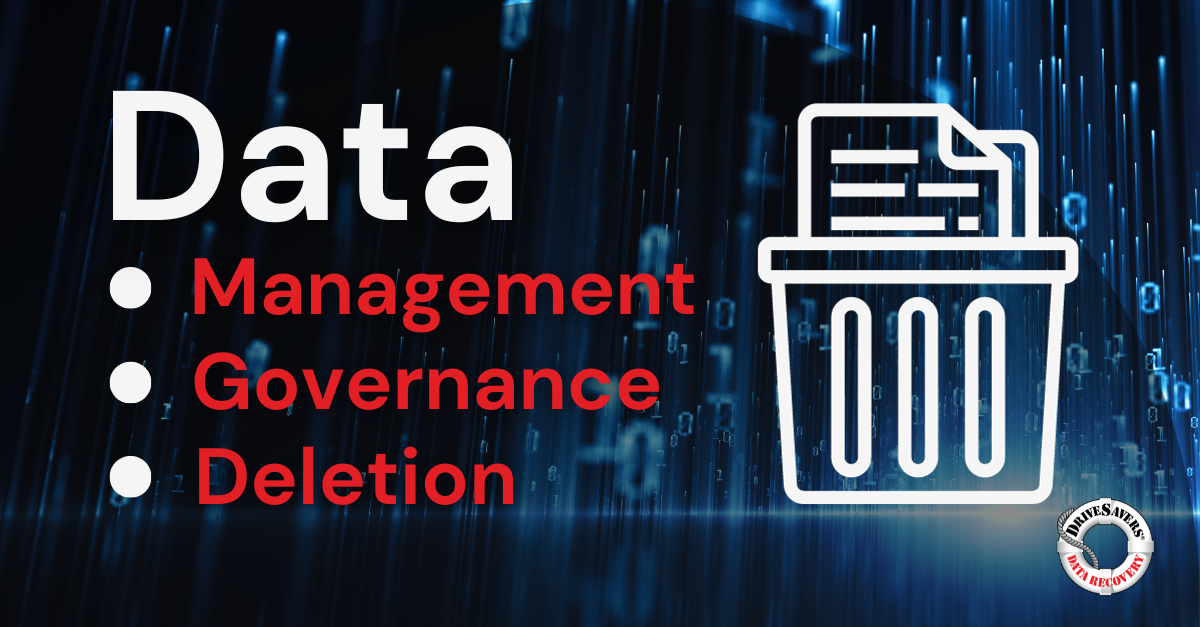In this article, we’ll break down what NIST 800-88 actually requires, why storage media of all types can defy expectations, and how verification services close the gap between intention and assurance.
Deleting Obsolete Data for Data Governance and Management

In today’s fast-paced digital world, businesses often grapple with a common challenge in data governance and management – dealing with old, no longer necessary data from the computers, servers, and other devices currently being used. Let’s explore why it’s crucial to remove outdated data, how it impacts digital storage, and the strategic steps IT professionals can take to maintain a streamlined and efficient data environment.

Why Eliminate Obsolete Data?
DriveSavers recommends you take this proactive safety approach annually. Outdated data clutters data storage devices. Removing it enhances device performance and acts as a safeguard against potential data loss, data leaks, and legal issues in the following ways:
Speed Up Access: Removing old data allows for faster and more reliable access to essential information.
Extend Storage Device Lifespan: Accumulated obsolete data can potentially lead to system overload and subsequent failure. Removing unnecessary items creates more space, allowing devices to last longer and reducing the risk of failure that could lead to data loss.
Avoid Additional Expenses: Obsolete data occupies valuable space, potentially necessitating additional storage, new devices, or upgraded servers. Deleting outdated files saves organizations from needing to purchase extra equipment.
Note: Before initiating any data deletion, ensure you’ve thoroughly read and understood this article and, most importantly, confirm you’ve backed up all the files onto an external device and labeled it for storage and future reference.
Identifying and Removing Obsolete Data
Understanding and identifying obsolete data is crucial for efficient data governance and management. Recognizing and classifying files based on criteria like legal necessity and compliance requirements is essential.
Examples of Obsolete Data:
- Data that is no longer needed for current legal or operational reasons (e.g., old customer records, financial data, or product information)
- Data that has not been accessed within a specified period (e.g., two years)
- Data that is no longer relevant to the organization’s current business needs (e.g., discontinued product lines)
- Duplicate files and older versions of current documents
- Data that is no longer required for compliance purposes
How to Identify Obsolete Data
-
- Define Criteria for Obsolescence: Identify files unnecessary for legal or operational reasons, those untouched for a specified period of time, and those no longer relevant.
- Use Tools: Data analytics applications identify infrequently used files and act as a helpful guide in the decision-making process.
- Review and Classify: Categorizing all files helps identify obsolete data, can provide an estimated time frame for when files that are still critical today may become obsolete, and streamlines the process for the future. Classify files based on importance, eliminating duplicates or outdated files:
- Data essential for business operations
- Data required for compliance
- Data that can be safely and legally deleted
Safety First in Data Governance and Management
Incorporating safeguards against data loss throughout the data audit process is essential. Before removing any data, it’s vital to establish and verify a backup. This acts as a safety measure, ensuring the recovery of lost data in cases of accidental deletion or device malfunction.
Safe Deletion: When deleting files, do it securely. Think of it as shredding sensitive papers for protection. Ensure compliance with relevant regulations and data privacy laws. It’s important to protect the organization legally and keep sensitive data safe from unauthorized access.
Back Up Essential Data: Implement a strong data backup and archiving system to protect vital information while eliminating unnecessary data. This guarantees that crucial data won’t be unintentionally deleted and stays accessible for recovery if a data loss event occurs.
Safely Store the Backed-Up Data: Store backed-up data as you would all backups – offsite, in the cloud, locked in a security box, or any combination that works best for your organization.
Integrating a data recovery service into the organization’s business continuity plan is a wise additional step. Data recovery can prove quicker and more cost-effective than attempting to recreate lost data. In situations where both the backup and production data have failed, data recovery might be the sole viable option. Having an established partnership can further speed data and business recovery.
Scheduled Data Governance and Managment
Based on the types of data identified during the categorization process and the amount of obsolete data found, determine an appropriate Data Retention and Disposal Policy that includes a schedule for regular management and obsolete data deletion. For some organizations, this should be done monthly or quarterly. For others, annually is fine.
Optimize Data Storage: By regularly removing obsolete data, organizations can free up valuable storage space, reducing the risk of running systems with overloaded storage capacity. This optimization extends the life of existing storage devices, curtails IT costs, and minimizes the risk of hardware failure resulting in data loss. Keeping a schedule also prevents obsolete data from accumulating, thereby making overall maintenance easier and less time-consuming.
Improve Access to Important Information: Outdated data can clog up storage systems, making it challenging to efficiently access crucial files. Deleting obsolete data, including older versions and duplicates, significantly enhances data accessibility and overall system performance, promoting higher productivity and efficiency for employees.
Ensure Compliance with Data Protection Regulations: Many data protection regulations mandate organizations to retain data for a certain period. After this period elapses, secure deletion is required. A routine data retention and disposal policy ensures compliance with these regulations, reducing the risk of legal and financial penalties.
A well-structured Data Retention and Disposal Policy is a vital asset for businesses of any size. It not only streamlines data governance and management but also helps reduce risks, ensure compliance, and strengthen overall organizational resilience.
Avoid Common Data Deletion Mistakes
In data management, ignoring important steps can lead to serious problems. For data protection, it’s crucial to avoid these mistakes when practicing data governance and data deletion:
Forgetting to Back Up: Accidentally deleting crucial files can be catastrophic. Always back up before initiating any deletion.
Leaving Old Data Unattended: Without a plan, old data accumulates, leading to overloaded devices and potential data loss.
Beware of Data Deletion Tools
It’s important to understand how tools designed for deleting data work. Most deletion tools wipe out the index on the device, leaving data on the drive accessible to those who have the know-how. If it is important to confirm the files are completely deleted, DriveSavers offers an Erasure Verification Service to verify complete erasure, guaranteeing your old data is truly deleted.
Before using any deletion tools, back up essential files.
Final Thoughts
Clearing out old data may seem like a mundane task; however, it’s a strategic move for any professional handling business IT. Implementing a regularly scheduled plan to delete outdated files maintains operational efficiency, facilitates quicker data access, and ensures compliance with regulations.
As you navigate the digital landscape of your business, remember that smart management of old data is integral to keeping everything in order.
If your organization ever deletes needed data or requires erasure verification to confirm the deletion of data from an intended device, call DriveSavers for Data Recovery or Data Erasure Verification Service. Call 1 (800) 440-1904 and speak with a specialist 24/7.





